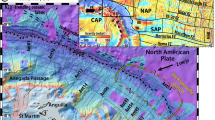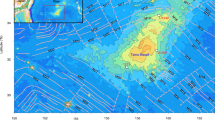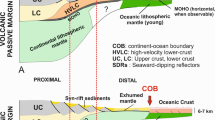Abstract
Dash and Bosshard1 have reported, on the basis of seismic reflexion and refraction profiling, that the five western islands of the Canary archipelago lie on normal oceanic crust. On the other hand, Lanzarote Island and Fuerteventura Island and Concepcion Bank (constituting the eastern group) seem to rest on continental or sialic crust. They suggest that a fault lies parallel with and westward of Fuerteventura, eastward of which the sediments on the sea floor are 6 km thick. Rothe and Schmincke2 further support this interpretation by suggesting that the western islands are typical oceanic volcanic cones built from sea-floor vents. In contrast, sedimentary strata in the eastern group show strong geological affinities to mainland Africa.
This is a preview of subscription content, access via your institution
Access options
Subscribe to this journal
Receive 51 print issues and online access
$199.00 per year
only $3.90 per issue
Buy this article
- Purchase on Springer Link
- Instant access to full article PDF
Prices may be subject to local taxes which are calculated during checkout
Similar content being viewed by others
References
Dash, B. P., and Bosshard, E., Proc. Twenty-third Intern. Geol. Cong., 1, 249 (1968).
Rothe, P., and Schmincke, H.-U., Nature, 218, 1152 (1968).
Sproll, W. P., and Dietz, R. S., Nature, 222, 345 (1969).
Dietz, R. S., and Sproll, W. P., Science, 167, 1612 (1970).
Carey, S. W., Continental Drift, A Symposium (edit. by Carey, S. W.), 177 (University of Tasmania, Hobart, 1958).
US Navy BC charts and sounding collection sheets (1:600,000), Nos.206N, 205N, 106N and 107N (US Naval Oceanographic Office, 1952).
Uchupi, E., Continental Margin Bathymetric Charts (1:1,000,000), I-475 (US Geological Survey, 1966).
Charts I-451 (US Geological Survey, 1965).
Chart 801 (Canadian Hydrographic Service of the Department of Energy, Mines and Resources, 1969).
US Navy BC Charts, Nos. 508 and 608 (US Naval Oceanographic Office, 1965, 1968).
Dietz, R. S., Holden, J. C., and Sproll, W. P., Geol. Soc. Amer. Bull. (in the press).
Dietz, R. S., and Holden, J. C., J. Geophys. Res. (in the press).
Rona, P. A., and Nalwalk, A. J., Geol. Soc. Amer. Bull. (in the press).
Rothe, P., Geol. Rund., 48, 314 (1968).
Bullard, E. C., Everett, J. E., and Smith, A. G., Phil. Trans. Roy. Soc., A, 258, 41 (1965).
Author information
Authors and Affiliations
Rights and permissions
About this article
Cite this article
DIETZ, R., SPROLL, W. East Canary Islands as a Microcontinent within the Africa–North America Continental Drift Fit. Nature 226, 1043–1045 (1970). https://doi.org/10.1038/2261043b0
Received:
Issue Date:
DOI: https://doi.org/10.1038/2261043b0
This article is cited by
-
Basal complex of Fuerteventura (Canary Islands) is an oceanic intrusive complex with rift-system affinities
Nature (1975)
-
Canary Islands?Origin and evolution
Die Naturwissenschaften (1974)
-
Evolution of La Palma, Canary archipelago
Contributions to Mineralogy and Petrology (1972)
Comments
By submitting a comment you agree to abide by our Terms and Community Guidelines. If you find something abusive or that does not comply with our terms or guidelines please flag it as inappropriate.



